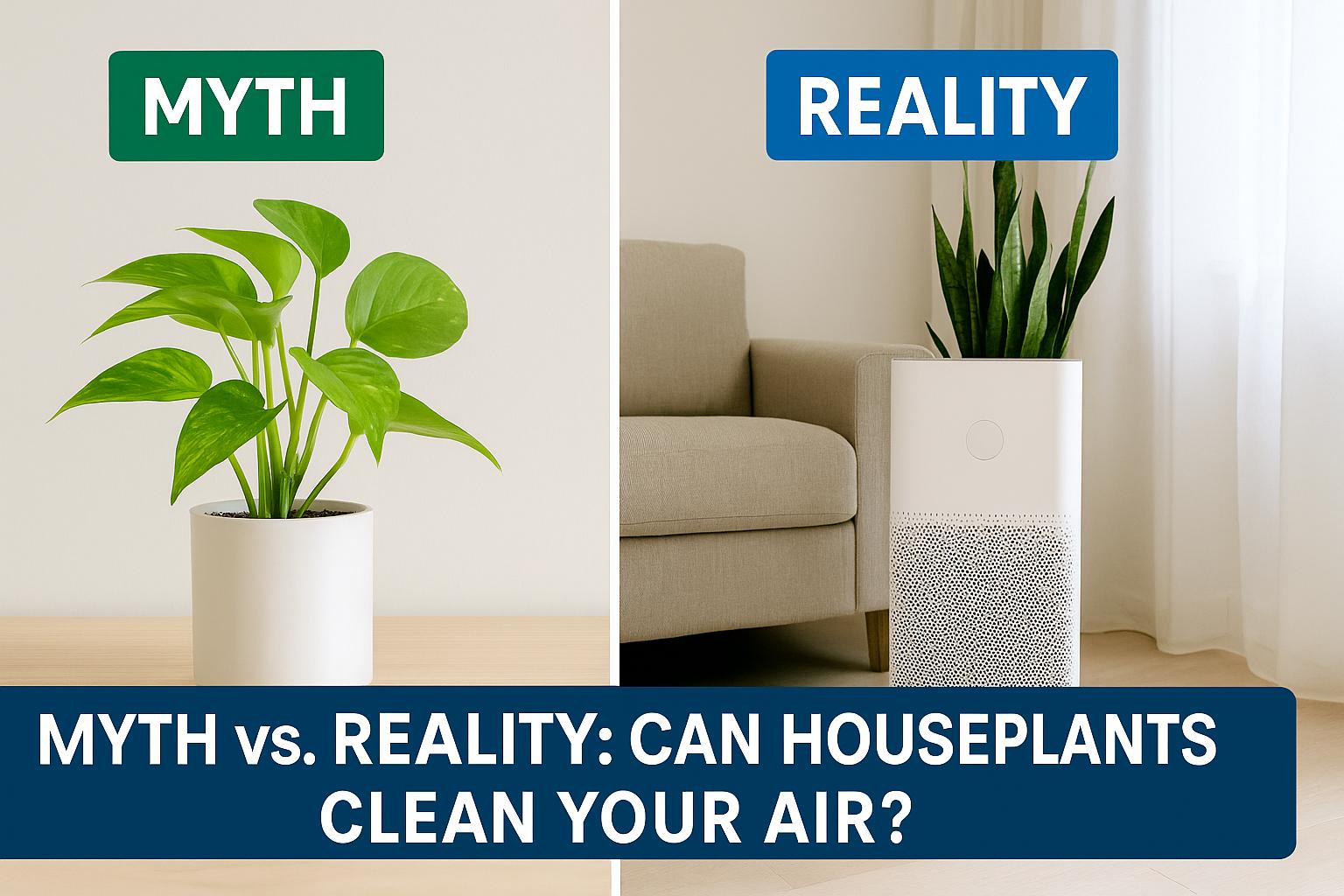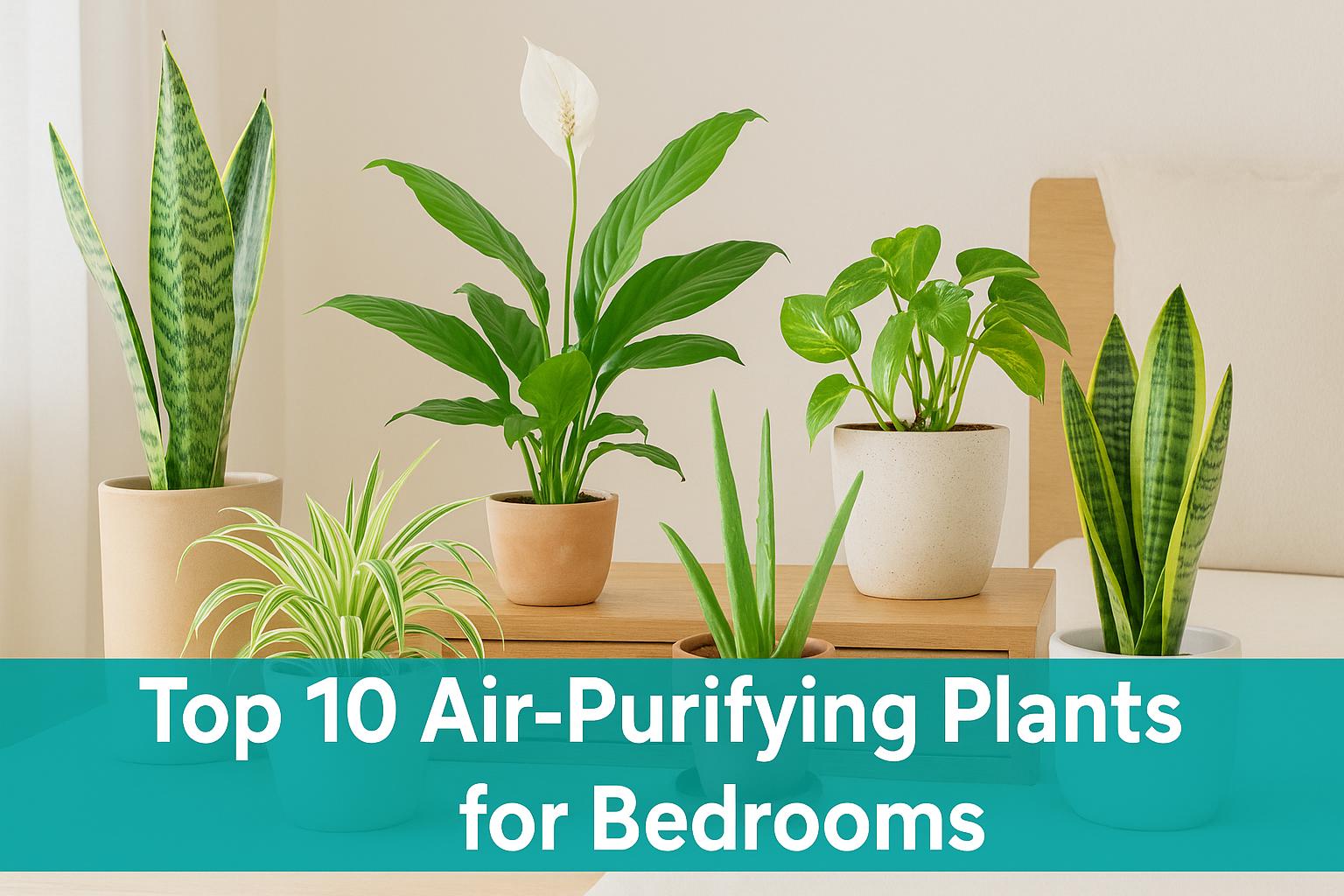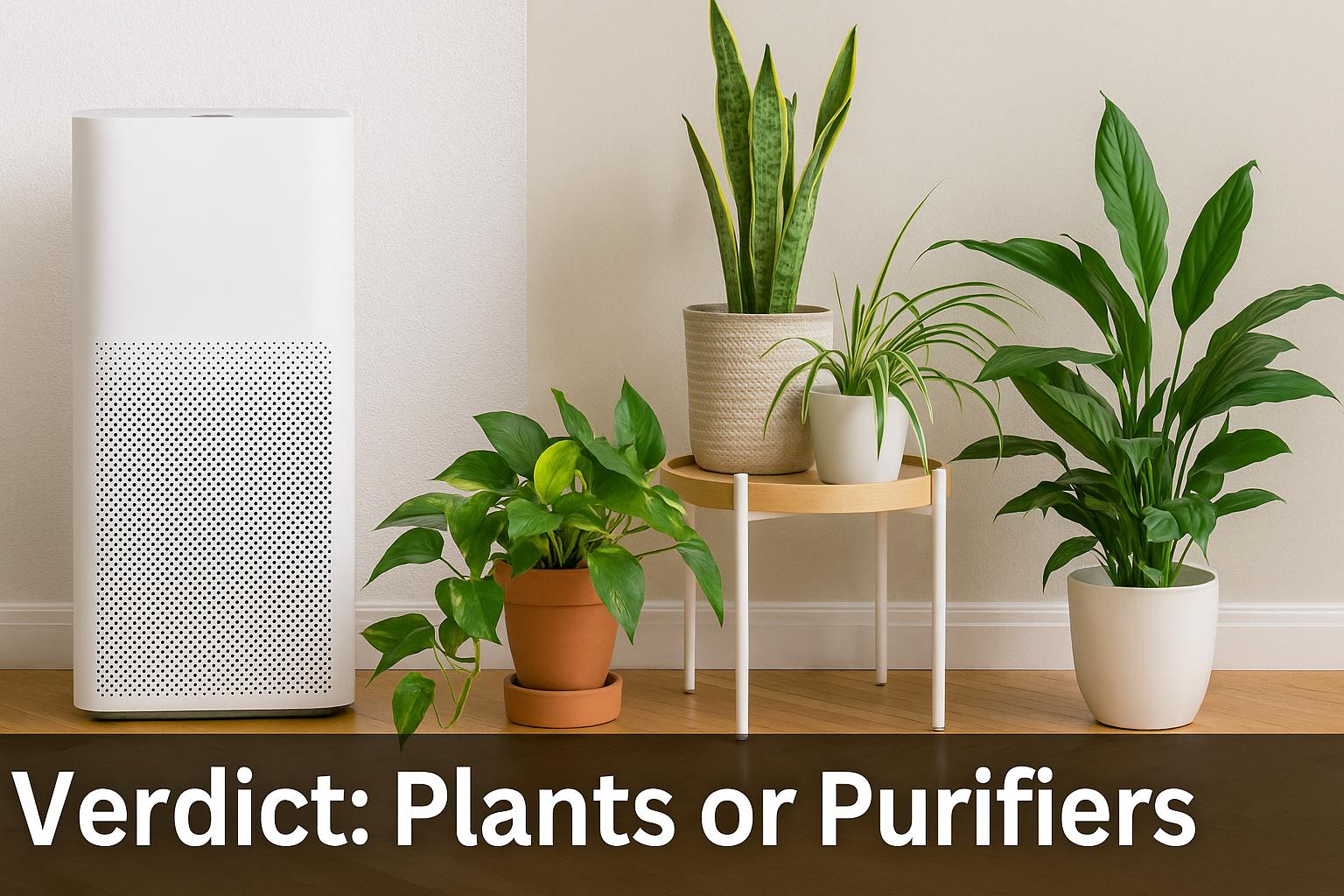
Air-purifying indoor plants have long been touted as a green solution to poor indoor air.
The famous 1989 NASA Clean Air Study found certain houseplants (Peace Lily, Snake Plant, English Ivy, etc.) could absorb volatile organic compounds (VOCs) like benzene and formaldehyde in sealed chambers.
This fueled a popular “plants purify air” belief. However, follow-up analyses showed those lab conditions don’t match a normal home. To equal NASA’s results, you’d need dozens or even hundreds of plants per room – clearly impractical.
In short, the plants purify air myth stems from these sealed-chamber studies, not real bedrooms.
Experts agree that a few houseplants can help a little (they add oxygen and humidity), but they won’t replace ventilation or a HEPA filter.
Still, plants offer other perks (less stress, better focus). and even small VOC reductions are a bonus.
So let’s break it down: which plants are easy, safe for bedrooms, and claim to improve air?
Can Plants Really Clean Indoor Air? (Myth vs Reality)

You've probably heard that plants can clean indoor air, but how true is this popular belief?
NASA's famous Clean Air Study has fueled this claim, but recent research provides a nuanced perspective.
While houseplants contribute to cleaner indoor air by reducing certain pollutants, they alone won't entirely purify your home.
Still, they significantly enhance aesthetics, humidity levels, and overall well-being, making them valuable additions.
Read Also
How To Protect Yourself While Gardening With Gloves: Ultimate Safety Guide
Top 13 Eco-Friendly Planters For A Sustainable Home Gardening
Do Air-Purifying Plants Really Work Indoors? (The Honest Truth)
While NASA's study is highly referenced, modern evaluations from sources like Which?
UK and Healthline suggest plants purify air slowly and modestly.
A plant-filled home offers incremental air purification benefits, but substantial results require numerous plants.
Additionally, experts from IAQ Works emphasize that plants are best viewed as supplemental rather than standalone air-purifying solutions.
Yet, the additional benefits—improved mood, humidity regulation, and aesthetics—make them worthwhile.
Top 10 NASA-Approved Air-Purifying Plants for Bedrooms

Top 10 NASA-Approved Air-Purifying Plants for Bedrooms
| Plant Name | Purifies Toxin | Light | Water | Benefits |
|---|---|---|---|---|
| Peace Lily | Formaldehyde, Benzene, VOCs | Indirect | Moderate | Humidity booster, easy care |
| Snake Plant | Benzene, Formaldehyde, Xylene | Low to Medium | Minimal | Releases oxygen at night |
| Aloe Vera | Formaldehyde, Benzene | Bright | Minimal | Medicinal + air purification |
| Rubber Plant | Formaldehyde, VOCs | Indirect | Minimal | Strong aesthetic appeal |
| Green Money Plant | Formaldehyde, Xylene | Low to Medium | Moderate | Prosperity symbol, low care |
| Areca Palm | Formaldehyde, Benzene | Indirect | Moderate | Humidity and oxygen booster |
| Lucky Bamboo | VOCs, General freshness | Low to Medium | Minimal (in water) | Vastu-friendly, low care |
| Spider Plant | Carbon Monoxide, Xylene | Indirect | Moderate | Beginner-friendly, non-toxic |
| Fiddle Leaf Fig | Formaldehyde, Benzene | Bright | Moderate | Stylish indoor decor |
| Boston Fern | Formaldehyde, Xylene | Indirect | High (misting) | Natural humidifier |
1- Peace Lily (Spathiphyllum).
This popular flowering plant is famous for its Peace Lily benefits for air.
Studies (and IAQ sources) note Peace Lilies remove up to 78% of airborne mold and can absorb ammonia, benzene and formaldehyde.
In practice it helps slightly scrub bedroom air.
It grows well in moderate light (even fluorescent light) and has elegant white blooms that add decor.
Care: Keep soil moist (water weekly) and trim spent blooms.
Note: Peace Lily is toxic to pets and humans if eaten
2- Snake Plant (Sansevieria/Dracaena trifasciata).
One of the most forgiving indoor plants, Snake Plant thrives on neglect – low light and infrequent watering.
It’s even NASA-approved: the NASA study listed mother-in-law’s tongue among the 10 tested plants.
Snake Plant absorbs formaldehyde, benzene, and carbon dioxide, and uniquely continues to release oxygen at night (good for a bedroom).
Care: Water sparingly (about once a month) and give any indirect light. It’s toxic if ingested, so keep away from pets/kids.
3- Aloe Vera
This handy succulent is a dual-purpose plant: its soothing gel is famous for burns, and it also helps clean air.
Aloe vera plant benefits for bedroom air include boosting nighttime oxygen and filtering toxins like formaldehyde and benzene.
NASA listed Aloe Vera as an effective air-cleaner thanks to its broad, toxin-absorbing leaves.
It grows best in bright light (a sunny window) and needs very little water.
Care: Water deeply but infrequently (allow soil to dry out completely) and give plenty of sun.
4- Rubber Plant (Ficus elastica)
A tall, upright plant with large, glossy leaves. Rubber plants are known to remove pollutants like formaldehyde from indoor air (though it was not in the NASA chart, it’s a common houseplant air filter).
It thrives in bright filtered light but tolerates moderate light. According to urbanplant.in, Rubber Plant is “easy to care for” with minimal maintenance
Care: Water when the top soil dries out and wipe leaves to keep them dust-free. It grows into a nice floor plant, filling space.
5- Pothos (Epipremnum aureum, “Green Money Plant”)
A cascading vine with heart-shaped leaves, Pothos (Green Money Plant) is a very easy bedroom plant – it tolerates low light and mild neglect.
It was one of the plants found to remove pollutants in the NASA study
Modern sources note it filters out formaldehyde, carbon monoxide and benzene as an air-purifying plant.
Urban Plant’s Green Money Plant page even touts that it “filters toxins, improving indoor air quality”.
Care: Thrives in low-to-medium light. Water only when soil is dry to the touch. Tip: Pothos can climb or hang; its
6- Areca Palm (Dypsis lutescens, “Butterfly Palm”)
A tropical-looking palm that grows well indoors in bright, indirect light.
Areca Palm adds humidity (good in dry bedrooms) and has been noted for indoor air benefits.
The Better India reports it can filter out solvents like xylene and toluene from the air, while also humidifying the room.
It’s non-toxic to pets and adds a softer, palm-like style to decor.
Care: Keep soil evenly moist (not soggy) and avoid direct harsh sun on its fronds.
7- Lucky Bamboo
Popular in Indian homes for good luck and minimal maintenance, it adds charm and freshness effortlessly.
8- Spider Plant
A classic hanging basket plant with arching green-and-white leaves. Spider Plant is extremely hardy (tolerates low light and occasional drying out).
NASA included spider plant in its tests, and it’s widely cited to remove formaldehyde and xylene.
Care: Water moderately and let the soil dry slightly between waterings. Spiderettes (“babies”) on long stems can be rooted for more plants.
9- Fiddle Leaf Fig
Stylish and effective, the Fiddle Leaf Fig cleans the air of harmful toxins and enjoys bright indirect light and moderate watering.
10- Boston Fern
Acting as a natural humidifier, Boston Ferns are excellent for air purification but require frequent misting and indirect light.
All the above plants do best in indirect light (avoid scorching sun) and most want moderate watering (soil moist but not drenched).
By placing a few of these low-maintenance indoor plants for clean air in your bedroom, you’ll enjoy a greener, fresher-feeling space.
(For example, Peace Lily and Snake Plant are sold on sites like UrbanPlant as easy indoor pick
In India, common houseplants like Snake Plant, Money Plant (Pothos), Areca Palm and Tulsi are especially handy – they grow well in local climates and filter everyday indoor pollution
Verdict: Plants or Purifiers?

In summary, plants do make your bedroom a healthier, more pleasant space, but they won’t overhaul air quality by themselves.
Decades of research (and modern meta-analyses) show that while houseplants can absorb VOCs, normal ventilation usually does that job better.
If you only rely on a few potted plants to purify the air, you’ll be disappointed.
The real value is that even a handful of indoor plants can slightly boost oxygen, raise humidity, and psychologically improve your well-being
In fact, WHO estimates indoor air pollution causes ~1.3 million deaths a year in India alone, so any improvement helps – however modest.
Our recommendation: treat plants as decorative air-fresheners, not sole cleaners. Combine them with good airflow or an air purifier for best results.
After all, the jury is in – yes you can say “houseplants purify air,” but with very limited scope.
Are Plants Better Than Air Purifiers? (Hybrid Tip Inside)
| Feature | Plants | Air Purifier | Winner |
|---|---|---|---|
| Toxin Removal | Moderate | High | Air Purifier |
| Aesthetic Value | High | Low | Plants |
| Electricity Required | No | Yes | Plants |
| Maintenance | Low | Moderate (Filter changes) | Tie |
| Mood Boosting | High | None | Plants |
Urban Plant Tip: Combine air-purifying plants with an air purifier for the best of both worlds — fresh air, natural beauty, and enhanced well-being.
What is the NASA Clean Air Study?
The NASA Clean Air Study identified indoor plants that can remove airborne toxins like benzene, formaldehyde, and trichloroethylene.
These plants act as natural air filters, reducing indoor pollution while improving oxygen levels.
FAQs: Air-Purifying Indoor Plants for Bedrooms
Do air-purifying plants really work?
Yes, but only to a small extent. NASA studies show they can absorb toxins, but in real homes, their impact is limited without ventilation.
Which plants are best for bedroom air purification?
Top picks include Snake Plant, Peace Lily, Aloe Vera, Money Plant (Pothos), and Areca Palm.
How many plants do I need to clean a room’s air?
Experts suggest dozens of plants per room are needed for noticeable results—so combine them with good airflow.
Are Peace Lilies safe for bedrooms?
Yes, but they are toxic if ingested—keep away from pets and children.
Which plant releases oxygen at night?
Snake Plant and Aloe Vera are known to release oxygen during nighttime, making them great for bedrooms.
What are low-maintenance indoor plants for clean air?
Snake Plant, Aloe Vera, Money Plant, and Spider Plant are low-maintenance and beginner-friendly.
Can plants replace air purifiers?
No. Plants offer small benefits but cannot replace a purifier or proper ventilation.
Which air-purifying plants are pet-friendly?
Spider Plant, Areca Palm, and Boston Fern are safe for homes with pets.
Is the air purifying plant trend a myth?
Not entirely—it’s based on lab studies. Plants help slightly, but not as much as people often think.
Where can I buy air-purifying plants in India?
You can find them online at Urban Plant with doorstep delivery and care guides.
How many plants do you need to purify a room?
NASA recommends at least one plant per 100 square feet for effective purification.
Do these plants help with sleep or health?
Yes! Snake Plants and Aloe Vera emit oxygen at night, improving sleep and reducing airborne irritants.





